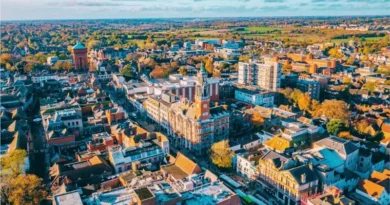The Savill Garden Windsor: All You Need to Know
Key Takeaways
- A Royal Botanical Treasure: Located in Windsor Great Park, The Savill Garden spans 35 acres of seasonal beauty. Founded in 1932 by King George V and Sir Eric Savill, it showcases vibrant landscapes, rare plant collections, and royal history.
- Seasonal Highlights:
- Spring: Snowdrops, cherry blossoms, and fritillaries signal renewal.
- Summer: Herbaceous borders and water lilies bloom in vibrant hues.
- Autumn: Trees transform into a fiery palette, complemented by dahlias and asters.
- Winter: Bare branches and frosted paths create serene beauty.
- Notable Attractions:
- Queen Elizabeth Temperate House: A glasshouse with exotic plants and giant water lilies.
- Rose Garden: Over 400 varieties, including historic blooms.
- Wooded Glade: Ancient oaks, bluebells, and the elusive ghost orchid.
- Dry Garden: Unique drought-tolerant plants in a Mediterranean-inspired setting.
- Sculptures and Water Features: Bronze art installations, reflective ponds, and playful fountains enhance the garden’s charm and invite moments of contemplation.
- Cultural and Learning Hub:
- The Savill Building: Offers horticultural exhibits, workshops, and a resource library.
- Events: Seasonal festivals, treasure hunts, and guided walks provide interactive experiences.
- Visitor Information:
- Open year-round, except Christmas Eve and Day. Seasonal hours apply.
- Easily accessible by car, bus, or train with well-maintained paths and wheelchair-friendly facilities.
- It is ideal for leisurely walks, picnics, and photography.
- Tips for Visitors:
- Visit during your favourite season for unique charms.
- Wear comfortable shoes for exploring paths.
- Respect nature by leaving no trace and embracing the tranquil atmosphere.
- Unique Features: The Savill Garden offers surprises at every turn, from royal tributes like the Jubilee Walk to rare plants such as Wollemia nobilis.
I. Introduction
Nestled within the sprawling 6,300-acre embrace of Windsor Great Park, just a stone’s throw from the majestic Windsor Castle lies The Savill Garden – a 35-acre haven of botanical beauty. Conceived in 1932 by the visionary duo of King George V and botanist Sir Eric Savill, this verdant paradise has blossomed into a vibrant tapestry of seasonal displays, diverse landscapes, and captivating history.
II. Unveiling the History of The Savill Garden
A. The Collaboration Between King George V and Sir Eric Savill
Windsor Great Park, sprawling emerald lungs adorned with ancient oaks and whispering winds, held a special place in the heart of King George V. Yet, within its vast embrace, a yearning bloomed for a garden unlike any other – a horticultural haven steeped in both beauty and knowledge. Enter Sir Eric Savill, a botanist whose boundless energy and passion for plants mirrored the King’s desire. And so, in 1932, a grand collaboration blossomed, giving birth to what we now know as The Savill Garden – a testament to two minds intertwined by a love for nature.
Sir Eric envisioned a tapestry of plants woven with threads of scientific rigour and artistic flair. He sought to create a learning lab disguised as a paradise, where visitors could not only be awestruck by floral majesty but also delve into the intricate workings of the botanical world. King George, an enthusiastic horticulturist himself, readily embraced this vision. He provided the land, financial backing, and unwavering support, becoming the silent gardener king whose patronage nurtured the young garden’s roots.
Their partnership resonated in the very design of The Savill Garden. Imagine, if you will, a canvas etched with emerald lawns and sinuous pathways, framing vibrant borders overflowing with blooms. Concealed within this vibrant tapestry lay pockets of tranquillity—the wooded glade, whispering secrets beneath ancient oaks, and the herbaceous borders, bursting with colour and fragrance, like nature’s confetti dance. Each meticulously chosen element whispered a tale of scientific inquiry and aesthetic delight.
B. The Evolution of The Savill Garden
The birth of The Savill Garden wasn’t a grand unveiling but a gentle unfolding. Over the years, it blossomed from a royal retreat to a public treasure. While the exact date of its opening to the public is uncertain, historical records suggest it occurred sometime in the 1950s. This transformation allowed all who sought botanical solace to wander its grounds, enriching the garden’s story with each new visitor.
In the 1950s, the Queen Elizabeth Temperate House emerged, a stunning glass palace sheltering exotic flora from distant lands. Its arrival marked a significant milestone, a breathtaking fusion of steel and glass whispering tales of faraway lands in English soil. The 1980s saw the Rose Garden bloom, a fragrant tapestry of crimson, ivory, and blush dedicated to the enduring reign of Queen Elizabeth II. Throughout the years, smaller stories unfolded – the tranquil Japanese Garden, a haven of serenity inspired by Japanese design principles, and the playful Dry Garden, a testament to life’s resilience in aridity, showcasing drought-resistant plants.
C. Notable Sections and Tributes within the Garden
The Savill Garden’s royal heart beats to this day, not just in its origins but in the subtle nods to its illustrious past. The Jubilee Walk, lined with commemorative trees planted for successive royal milestones, whispers tales of celebrations past. The Golden Jubilee Garden, a riot of colour and fragrance, stands as a vibrant ode to Queen Elizabeth II’s 50-year reign. And tucked away, like a hidden jewel, lies the King’s Pool, a serene reflection of the sky, named after its royal patron, a silent testament to the enduring legacy of a king who dreamt of a botanical paradise.
III. Exploring the Garden’s Ever-Changing Tapestry
A. Springtime Symphony
As winter’s frosty clutches loosen, the garden explodes in a joyful riot of colour. Imagine, if you will, the Snowdrops, like shy ballerinas in white tutus, peeking out from under melting frost. Daffodils and trumpets blaring yellow sunshine announce the arrival of warmer days. Cherry blossoms, a frothy pink meringue, blanket the trees, showering petals like confetti on the wind.
But wait, there’s more! Look closer, and you’ll find treasures tucked away: the delicate mauve blossoms of Snake’s Head Fritillary, like miniature dragons rising from the soil, and the vibrant blue of Chionodoxa, resembling forget-me-nots that refuse to be forgotten. Even the air tingles with a heady perfume – a chorus of hyacinths and freesias singing their fragrant tune.
B. Summer’s Lush Embrace
Summer arrives, draped in a cloak of emerald green and a crown of vibrant blooms. The herbaceous borders become a whirlwind of colour – fiery lilies tango with blushing geraniums. Meanwhile, foxgloves stand tall like regal sentinels in purple velvet. Roses, in their infinite shades of crimson, gold, and ivory, unfurl their fragrant flags, perfuming the air with a heady sweetness.
But hush, don’t miss the whispers of the hidden gems! Seek out the Waterlily House, where giant Victoria amazonica pads, like prehistoric platters, hold waterlily blooms the size of dinner plates. In the Queen Elizabeth Temperate House, butterflies flutter amidst exotic blooms, tiny hummingbirds, jewels on wings, and sip nectar from delicate orchids.
C. Autumn’s Golden Palette
The Savill Garden undergoes a stunning transformation as days shorten and leaves begin fiery descent. Emerald gives way to ochre, crimson, and gold as trees don their autumnal finery. Like flamboyant dancers in satin gowns, Dahlias strut their stuff in shades of ruby and plum. Golden marigolds and fiery asters paint the borders with warm hues, while plump pumpkins and squashes peek out like mischievous jesters from under the foliage.
But autumn isn’t just about showmanship – it’s a season of abundance. Blackberries and elderberries hang heavy on the branches, inviting peckish birds and curious visitors alike. The Savill Building becomes a treasure trove of colourful squashes, gourds, and pumpkins, a testament to the garden’s bounty.
D. Winter’s Tranquil Interlude
The final act of the year unfolds in a hushed whisper. Gone are the vibrant blooms, replaced by a stark beauty of bare branches and frosted lawns. Yet, even in winter’s slumber, the garden holds a quiet charm. Mistletoe adorns the oaks, a festive invitation for feathered friends. Winter Walk offers a contemplative path within when it graces the ground, the piece, each twig and branch etched in stark relief.
The Winter Walk offers a contemplative path within the serene heart of the garden. Here, amidst the slumbering plants, you can find solace in the silence, a time for reflection, and a promise of springtime’s vibrant dance to come.
IV. Unveiling the Garden’s Diverse Landscapes
A. The Wooded Glade
Imagine dappled sunlight filtering through ancient oaks, Painting patterns on mossy stones. Breathe in the earthy scent of fallen leaves and the damp whisper of ferns. You’ve entered the Wooded Glade, a sanctuary where time seems to slow and worries melt away. Towering beech trees whisper ancient secrets, their gnarled roots weaving intricate patterns amongst the undergrowth. In spring, delicate wood anemones paint the forest floor with pastel hues. At the same time, bluebells create a shimmering carpet under the leafy canopy.
But keep your eyes peeled for hidden treasures! The elusive ghost orchid, a pale spectre clinging to decaying wood, might flit into view. And beneath the fallen leaves, the shy badger might leave its nocturnal tracks, a reminder of the unseen life that thrives in this verdant haven.
B. The Herbaceous Borders
Step out of the glade’s emerald embrace and be embraced by a kaleidoscope of colour. The herbaceous borders are a sensory feast stretching like vibrant ribbons across the landscape. Imagine fiery lilies reaching for the sun, their crimson petals a beacon against the lush green backdrop. Picture swathes of lavender undulating in the breeze, their fragrant mist inviting a deep breath. And make sure to catch the playful dance of butterflies, flitting from poppy to daisy, adding a touch of whimsical magic to the scene.
But this isn’t just a visual spectacle – it’s an aromatic odyssey. Honeysuckle whispers its sweet perfume while the spicy allure of oregano and the citrusy tang of lemon thyme tickle your nose. And listen closely – you might hear the rhythmic hum of bees, nature’s tiny pollinators busy collecting nectar from this floral bounty.
C. The Rose Garden
Now, close your eyes and follow the intoxicating scent. It leads you to a haven of delicate blooms, a fragrant palace carved from petals – the Rose Garden. Here, over 400 rose varieties vie for your attention, each a masterpiece of colour and perfume. Blush pink tea roses mingle with fiery climbers, while vibrant hybrid teas stand tall, their velvety heads held high with regal pride.
But even in this realm of elegance, there’s room for quirky charm. Seek out the “Green Rose,” its petals an unexpected verdant hue, or the “Rhapsody in Blue,” a lavender wonder defying the traditional red and pink palette. And for a touch of history, whisper hello to “Gloire de Dijon,” a fragrant veteran bearing the scars of its 1860 birth yet blooming as magnificently as ever.
D. The Queen Elizabeth Temperate House
Step through the glass doors and prepare to be transported. You’ve just entered a slice of the tropics nestled in English soil’s heart. The Queen Elizabeth Temperate House is a botanical wonderland, where humid air hangs heavy with exotic scents and vibrant flora unfurl in all their glory.
Gaze in awe at the giant water lilies, their lily pad thrones holding delicate, star-shaped blooms. Hummingbirds, jewels on wings, flit amongst orchids and bromeliads while ferns unfurl their prehistoric fronds from damp corners. But don’t miss the hidden gem – the Wollemia nobilis, a living fossil tree thought extinct for millions of years yet thriving in this microcosm of its ancient forest home. This remarkable tree can be found towards the back of the Temperate House, a testament to the diversity of plant life nurtured within its walls.
E. Beyond the Borders
The Savill Garden’s magic isn’t confined to its well-trodden paths. Every turn, every hidden corner, holds a surprise. Seek the tranquil Japanese Garden, where koi fish weave through a miniature water world beneath weeping willows. Explore the Dry Garden, a testament to life’s resilience in the face of aridity, where succulents and cacti thrive in surprising harmony. And don’t miss the quirky Herb Walk near the Jubilee Walk, where fragrant rosemary brushes against peppery nasturtiums, reminding you that the garden’s bounty extends beyond mere aesthetics.
V. Discovering the Hidden Treasures of The Savill Garden

A. Sculptures Amidst Nature
Imagine giant spiders woven from bronze, their spindly legs anchoring them amongst the ferns of the Wooded Glade. Or picture ethereal glass spheres reflecting the sky, perched atop a hill like fallen moons—these, my friends, these sculptures pepper The Savill Garden, blending seamlessly with the natural world.
Wander amongst the trees, and you’ll encounter “The Kiss,” a poignant bronze embrace in the greenery. Follow the path and stumble upon the playful “Bird on a Wire,” its metallic form perched on a real branch, blurring the lines between reality and art. And for a dose of the surreal, seek out “The Watcher,” a colossal head emerging from the undergrowth, its gaze both captivating and unnerving.
But these sculptures aren’t mere visual distractions – they invite contemplation, a dialogue between nature and creation. Each piece whispers a story, prompting you to consider your place within this verdant tapestry. So, open your eyes, embrace the unexpected, and discover the art that breathes life into The Savill Garden.
B. Water Features
Water, the garden’s lifeblood, plays a starring role in its visual symphony. From tranquil ponds mirroring the sky to playful fountains dancing in the sun, water features add an element of dynamism and serenity to the landscape.
Seek out the serene Kingfisher Lake, where dragonflies patrol the shimmering surface, and reeds whisper secrets in the breeze. In the heart of the Rose Garden, find the elegant Cascade, its gentle rhythm a counterpoint to the fragrance of blooms. And if you’re feeling adventurous, follow the babbling stream that snakes through the Wooded Glade, a liquid trail leading to hidden wonders.
But water also possesses a playful side. In the Dry Garden, a mischievous fountain sends jets of water skyward, teasing the cacti and succulents with a taste of rain. And the Children’s Play Area boasts a giant, spouting frog, guaranteed to elicit squeals of delight from even the most jaded visitor.
C. The Savill Building
Nestled amidst the greenery, the Savill Building isn’t just a brick-and-mortar structure—it’s a portal to knowledge and inspiration. Step inside and discover a treasure trove of horticultural history and a library brimming with botanical wisdom. Exhibits showcase the garden’s story, from its royal origins to its dedication to scientific research.
In the Learning Centre, workshops and talks unfold, offering insights into everything from pruning roses to identifying wildflowers. While some workshops may have a separate fee, the Learning Centre offers a variety of free talks and resources throughout the year. Check their website or inquire at the building for the latest schedule and any potential workshop fees.
And if your artistic spirit craves nurturing, take a pottery class or learn the art of floral arranging, channelling the garden’s beauty into your own creative endeavours. So, whether you’re a seasoned botanist or a curious newcomer, the Savill Building offers something for everyone. Come to learn, be inspired, and discover this verdant paradise’s hidden depths.
D. Events and Activities
The Savill Garden isn’t a static Painting – it’s a vibrant stage where events and activities unfold throughout the year. From family-friendly treasure hunts to guided walks exploring fascinating fungi, there’s something to ignite the imagination of every visitor.
Join the annual Art in the Garden exhibition, where sculptures by contemporary artists weave between blooms and foliage, sparking dialogues between nature and creation. Celebrate the changing seasons with special events, like the Spring Bulb Festival or the Autumn Pumpkin Trail, each unique immersion into the garden’s ever-transforming beauty.
For those who crave a more profound connection, learn the art of willow weaving or participate in a mindful walk, allowing the garden’s tranquillity to wash over you. These events are more than just entertainment—invitations to experience The Savill Garden in new and enriching ways.
VI. Planning Your Visit: A Practical Guide to The Savill Garden

A. Opening Hours:
Consult the garden’s opening hours and admission fees before packing your picnic basket and lacing up your walking shoes. The Savill Garden welcomes visitors all year round, except for Christmas Eve and Christmas Day. Opening hours vary depending on the season, so be sure to check the official website for the latest information. Generally, expect opening times between 9:00 am and 4:30 pm, with the last admission granted at 3:30 pm.
B. Getting There and Getting Around:
The Savill Garden sits nestled within Windsor Great Park, easily accessible by various means.
- Car: Follow the brown tourist signs for Windsor Castle and Windsor Great Park. Plenty of parking options are available within the park, although charges apply. Check the official website for current parking fees and locations.
- Train: Windsor & Eton Central Station is a short walk from Windsor Castle. While there isn’t a free shuttle bus directly from the station to The Savill Garden, you can take a public bus service or a taxi for a convenient journey.
- Bus: Several bus routes serve Windsor Great Park, stopping near The Savill Garden entrance. Check public transport journey planners or inquire at the station for the most up-to-date routes and timetables.
Once you arrive, navigating the garden is a breeze. A network of well-maintained paths winds through the various sections, offering both leisurely strolls and adventurous explorations. Maps and signage are readily available to guide you but don’t hesitate to ask a friendly garden staff member for directions or recommendations.
C. Tips for a Perfect Visit:
To ensure your visit to The Savill Garden is as delightful as possible, keep these tips in mind:
- Choose the right season: Each season offers its own unique charm. Spring bursts with colour, summer delight with vibrant blooms, autumn paints the landscape in fiery hues, and winter offers a serene tranquillity. Consider your preferences and plan your visit accordingly.
- Wear comfortable shoes. You’ll be doing a fair amount of walking, so choose footwear that will keep your feet happy throughout your exploration.
- Pack a picnic: Enjoy a delightful lunch amidst the greenery. Designated picnic areas are available, or choose your own idyllic spot under a majestic oak.
- Bring sunscreen and a hat: Sun protection is essential during the warmer months.
- Take your time: Don’t try to rush your visit. The Savill Garden is a place to savour, let the beauty seep in, and discover hidden treasures at your own pace.
- Bring your camera: Capture the garden’s magic in photographs, but remember to absorb the beauty with your own eyes.
- Leave no trace: Respect the garden and its inhabitants. Dispose of your litter properly and be mindful of your surroundings.
D. Accessibility Information:
The Savill Garden strives to offer an accessible experience for all visitors. Most paths are wide and level, suitable for wheelchairs and pushchairs. Accessible toilets are available throughout the garden, and several wheelchairs can be borrowed at the entrance.
Additionally, the Savill Building houses an accessible lift and facilities, and guided tours can be arranged with prior notice for visitors with visual or hearing impairments.
As you step through its gates, remember – that this isn’t just a garden; it’s an invitation to slow down, reconnect with nature, and rediscover the magic that unfolds beneath the emerald sky. Happy exploring!
VII. FAQ
Can I bring my dog to The Savill Garden?
Dogs are not permitted inside The Savill Garden, except for registered assistance dogs. However, Windsor Great Park offers dog-friendly areas nearby.
Are bicycles allowed in the garden?
Bicycles are not permitted within The Savill Garden. Bike racks are available near the entrance for secure parking.
Is there a café or restaurant onsite?
Yes, The Savill Garden Kitchen offers a variety of refreshments, including seasonal dishes, light lunches, and desserts, with indoor and outdoor seating options.
Are there guided tours available?
Guided tours are available, typically led by knowledgeable garden staff. Check the garden’s website or contact the Visitor Centre for schedules and bookings.
Is there a discount for group visits?
Yes, discounted rates are available for pre-booked groups of 10 or more. Contact the Visitor Centre for further details on group packages.
What accessibility facilities are provided?
The Savill Garden is wheelchair accessible, with smooth paths, ramps, and disabled parking spaces. Wheelchairs and mobility scooters are available to hire for free, but booking in advance is recommended.
Are there family-friendly activities?
Yes, seasonal treasure hunts and interactive workshops cater to children, making it an engaging experience for families.
Can I host a private event or wedding at The Savill Garden?
The Savill Garden offers event spaces for private functions, including weddings. Contact the event team for venue hire details and arrangements.
Are plants or souvenirs available for purchase?
A gift shop located in The Savill Building offers plants, gardening accessories, and souvenirs inspired by the garden.
Can I picnic in The Savill Garden?
Picnics are not allowed inside the garden. However, there are designated picnic areas nearby within Windsor Great Park.









